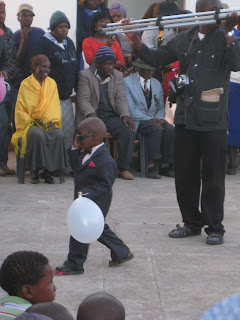Camp Hope is a camp that is hosted every year (for the past 6 years) for children who attend our clinic. I wrote about it last year as well (see Aug'09), but this year I knew the children a lot better after taking care of them in clinic for the last year and I was able to spend more time at the camp. Once again I was reminded of the extreme burden that HIV places on these children's lives. Most of the children are at least single orphans (having lost one parent) and many are double orphans (having lost both). Our clinic has over 2,000 children and we can only take 50 children at camp each year. So we restrict it to children ages 10-12 years and try to invite those who have more complex issues (poor adherence to medications, lack of social support, psychological problems, etc). It is always hard to choose who should be able to go because really they should all get the chance.
We try to make camp completely about having fun. The children are all given their medications twice (or in some cases more often) a day. They all get to see that everyone at the camp is taking medications and they are not alone, but otherwise we don't mention HIV. There were different activities each day arts and crafts (they each made hope dolls, decorated and dressed in style as above and below), dance, exploring feeling and emotions, sports, cooking and nutrition, and character development and each of the 6 color teams rotated through the activities getting a chance to try each one out.
We took a trip to Mokolodi, the game reserve and educational center, which is only 20 mins from the city and yet the vast majority of the children have never been there to see some of the animals that bring tourists flocking to their country each year.
We also had Camp Hope Olympics which involved everything from sack races to trying to eat donuts tied to stings with your hands tied behind your backs.
I played the role of camp doctor, face painter (see some of my handy work below - and yes the face painting was all done by camper request, not sure why she wanted a giant US flag on her face, but ask and you shall receive when at camp), human jungle gym, arts and crafts helper, and I dispensed plenty of hugs! It was a great week and a chance for everyone to just have fun and be a kid. At the end of camp on Thursday morning the caregivers were all invited for a slide show of photos from the week and the children performed the song and accompanying dance that had been our theme song for the week. R Kelly's "I'm the greatest." Watching 50 HIV positive children dance and sing "I made it, I'm the world's greatest" brought tears to my eyes. (If you don't know the song you can find it on youtube: http://www.youtube.com/watch?v=LyaNlZaVOpc, I can't post the video of the kids dancing because not all of them have photo consent, but take my word for it when I tell you it was incredibly moving) At the end of the presentation, a caregiver of one of the 11 yr old boys came up to me and thanked me for inviting T.S. (her nephew) to camp. She said "when I dropped him off on Sunday he was really shy and now I see that he has made friends and he is up there dancing, it is so amazing."
 |
| Each camper received a certificate of participation or graduation depending on their age and if they will be eligible to come back to camp next year. They were all so thrilled. |































